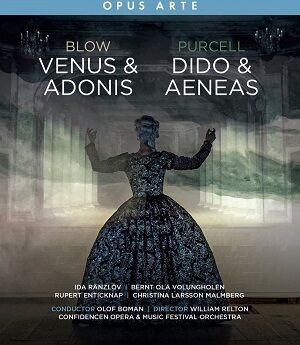
John Blow (1649-1708)
Venus and Adonis (1683)
Henry Purcell (1659-1695)
Dido and Aeneas (1689)
Ida Ränzlöv (mezzo-soprano) – Venus, Dido
Berndt Ola Volungholen (baritone) – Adonis, Aeneas
Rupert Enticknap (counter-tenor) – Cupid, Sorceress
Christina Larsson Malmberg (soprano) – 2nd Muse/Lady-in-waiting, Belinda
Confidencen Opera and Music Festival Orchestra/Olof Boman
William Relton (director)
rec. 2021, Confidencen Theatre, Sweden, August
OPUS ARTE OABD7308D Blu-Ray [98]
This double-bill of seventeenth century English operas is promoted by Opus Arte as a coupling of “two classic court operas.” In fact that description might only really be applied to Blow’s Venus and Adonis, as Purcell’s Dido and Aeneas, at any rate in the version by which we know it today, was designed for performance at a school of gentleladies in Chelsea. But both share the sensibilities – and exuberances – of the Restoration theatre, with its bawdy titillations designed to appeal to the court of the lascivious Charles II and his Stuart successors, product of an anti-puritan reaction which continued unabated despite the turmoil of revolutionary ferment which overtook the country during the 1680s. Both operas focus on an ill-starred pair of lovers from classical mythology, overlaid with a layer of knowing cupids and malevolent witches, which by that era were ceasing to becomes symbols of either erotic desire or terror and taking on a more comic aspect.
The productions here underline the parallels between the two operas by casting the same pair of singers in the roles of the lovers, and assigning the minor roles to the same group of supporting artists. Similarly the scenery, demonstrating with superb showmanship the dramatic potentialities of painted backdrops sliding onto and off the stage, allows for rapid changes between various locations and some quite spectacular lighting effects – for example during the storm in Dido and Aeneas – which demonstrate the unexpected realism that could be achieved under theatrical conditions at the time. The costumes, a slightly incongruous combination of restoration fashion and what was conceived of at the time as Grecian draperies, strike a modern and ironic touch which nevertheless serves to add a delicious spice of naughtiness to proceedings. One doubts however that the modern fashion for unshaven male chest hair – most luxuriantly displayed by Volungholen’s Adonis – would have been regarded by either the Greeks or their Carolingian imitators as authentic. When the same singer appears in courtly dress as Aeneas in the Purcell opera, he is hardly recognisable. Similarly the modern appearance of Cupid in the Blow opera, like a sort of epicene Christopher Robin, is startlingly different from the same singer in full court gown as the sorceress in Purcell’s extravagant evocation of witchery. It is not uncommon to cast the role with a tenor singer, following the example of earlier renaissance opera nurses and grandmothers in operas by Monteverdi and Cavalli, but the cheery Enticknap makes a good fist of the part as a counter-tenor even if he has suddenly and unexpectedly acquired a pair of crutches to get about the stage in the second half (was there an accident in the theatre?).
But in both these operas the central focus of attention in on the tragic heroines; neither of their male counterparts or assistants have anything like as much to do. And it is here that the whole performance really triumphs, with the superb singing of Ida Ränzlöv as both Venus and Dido. Her English, not quite impeccable, is certainly more than adequate; her phrasing and delivery are immaculate; and she follows in the honourable tradition of a whole series of Continental singers who have essayed the role of Dido over the years, beginning with Kirsten Flagstad and Victoria de los Angeles in the 1950s and 1960s. This is not perhaps such a richly rounded voice as some of those who have undertaken the part – Jessye Norman, Maria Ewing, Tatiana Troyanos – but it is a long way from the sometimes etiolated sounds of many baroque specialists, ringing out freely and gloriously in the upper register and becoming properly desolate and emotional as the tragedy unfolds. The closing scene of Dido, as the queen walks solemnly towards the fire kindled for her at the back of the stage, is very moving and the choral singing has both delicacy and power as required. Some more puritanically minded baroque purists may object, but I cannot conceive – or concede – that the romantic style of engagement here is wrong.
The performances throughout are enchanting, and the staging with its delicate flecks of fantasy and sheer cheek is a delight to behold. The small body of choral singers and the period-instrument orchestra are splendidly controlled by Olof Boman, and the manner in which the orchestra are seated in the baroque opera pit, partly looking up at the singers on stage and partly to the conductor at the right, allows for an interaction between performers on both sides of the proscenium which can be palpably felt and seen in places. This is a most thoroughly enjoyable theatrical and musical experience. One looks forward eagerly to future productions from this gem of a Swedish baroque building with its lively acoustic.
The booklet, in English only, is basically functional – the briefest of synopses, no background information of the operas themselves, and track listings limited to individual scenes rather than separate numbers – but plentifully illustrated in colour. Subtitles do however come in English, French, German, Japanese and Korean.
Paul Corfield Godfrey
Help us financially by purchasing from



Other details
Lisa Carloth (soprano) – Shepherdess/1st Muse, 2nd Woman/1st Witch/Courtier
Mathilda Siden Silfver (mezzo-soprano) – Shepherdess/1st Huntsman/3rd Muse, 2nd Witch/Spirit/Courtier
Mikael Stenbaek (tenor) – Shepherd/2nd Huntsman, Sailor/Courtier
Arash Azarbad (tenor) – Shepherd/3rd Huntsman, Courtier
Sarah Ekman (choreographer)
Christer Nilsson (set design)
Sofie Anderson (lighting design)
Anna Khellsdotter (costume design)
Audio formats: LPCM 2.0, dts-HD Master Audio
Screen ratio: 16:9, all regions


















